I visited French Riviera or Côte d’Azur, as this part of the Mediterranean coast is also called, with my brother many, many years ago. At that time, the two of us passed here with a tourist group travelling by coach to Barcelona. I can still remember some details, but very sketchy, while in the meantime many things have changed in my life. On the other hand, the French Riviera has simply remained as attractive as ever. Aside the fact that this is the place where the wealthy people of this world like to congregate or to live – I did not care about this before and I certainly don’t care about it now. For me, it was important that this was the coast of the Mediterranean Sea in the early spring and that promised a nice, pleasant and relaxing, albeit short vacation. This time around, my plans concentrated on visiting Nice and different places in its surroundings, since I had a direct flight to this city where I rented a small flat in the centre. Here is a map that shows which places I went to during this week.
Still, before arriving in Nice, I could enjoy some of the sights of the French Riviera from the plane.
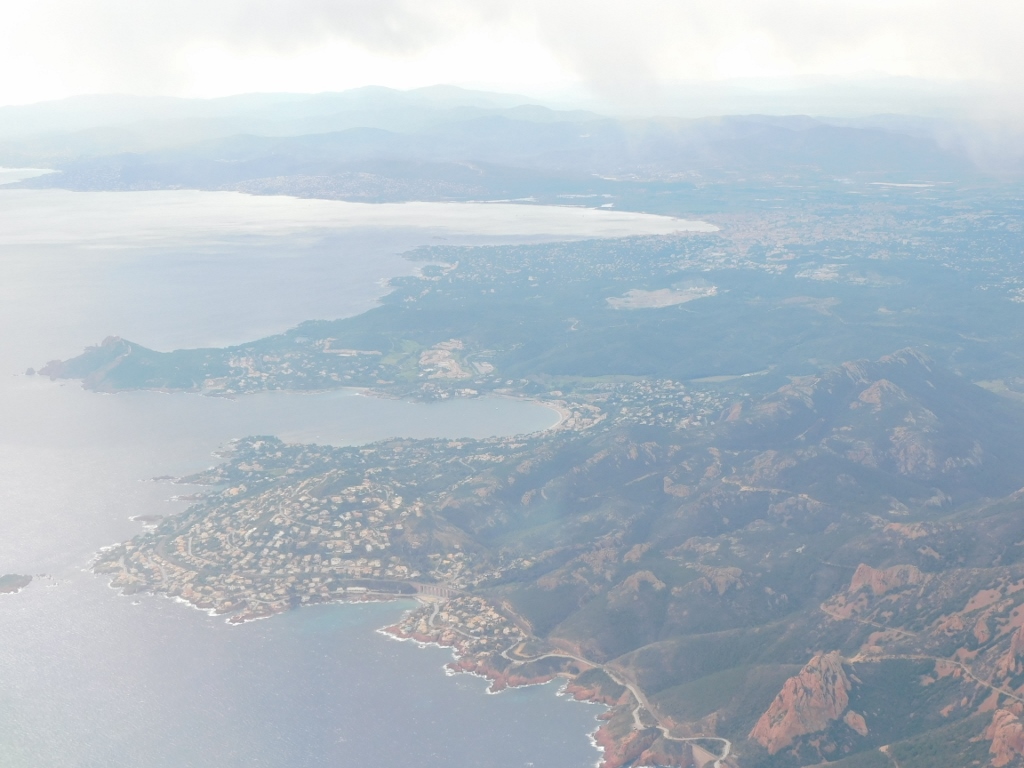 French Riviera
French Riviera
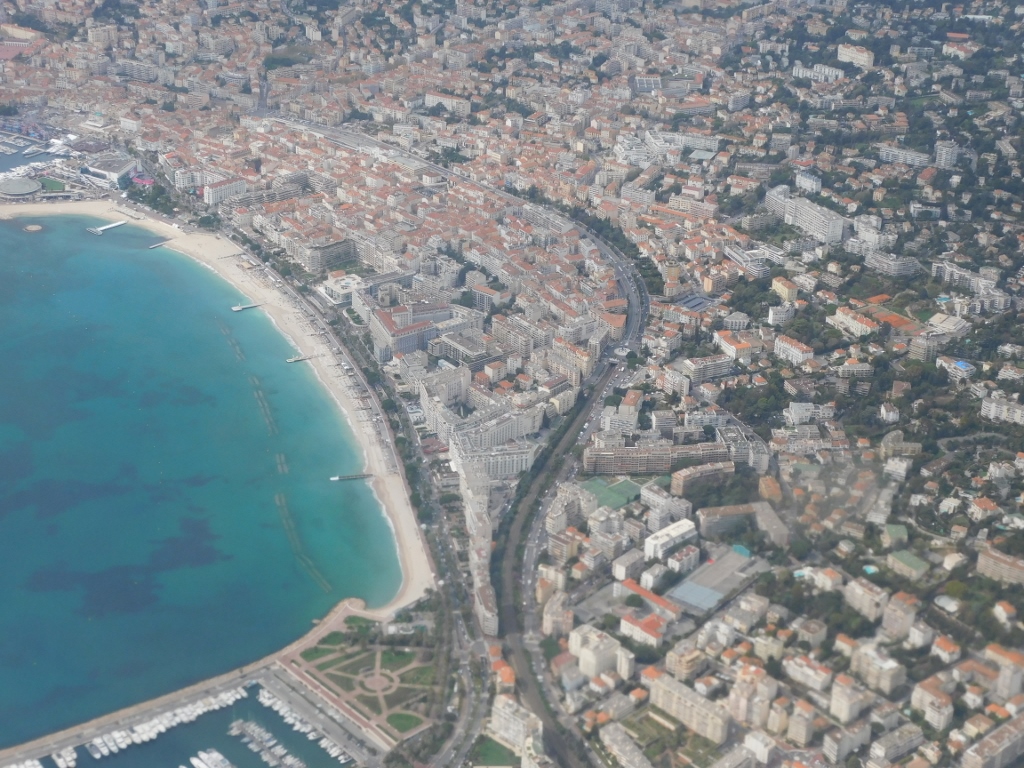 Cannes as seen from the airplane
Cannes as seen from the airplane
It is easy to get from the airport in Nice to the downtown area using a tram (which occasionally seems like an underground, because that is where it goes). The ticket should be bought at an automatic vending machine on the platform and it is very important to stamp the ticket in one of the devices on the tram. If the travellers do not do that, it seems as if they don’t have the ticket and then a significant fine must be paid.
It took me a mere dozen minutes on foot to get from the tram station to the flat that I rented. As soon as I settled, and that entailed taking out any surplus of things from my small backpack, I dashed out, since the weather was quite fine – mostly sunny, but more importantly – dry.
I was a little hungry, but not so much that I would sit somewhere to eat, while in the meantime I learned the address of a bakery that make croissants in the traditional way, which means using butter. Although croissants are usually eaten in the morning (and this was already afternoon), I did not mind this and just walked to the bakery buying there the last croissant made on that particular day (since the bakery is renowned for making new, fresh croissants every day). I ate it with great content while going towards a lovely, wide walking area along the Mediterranean Sea.
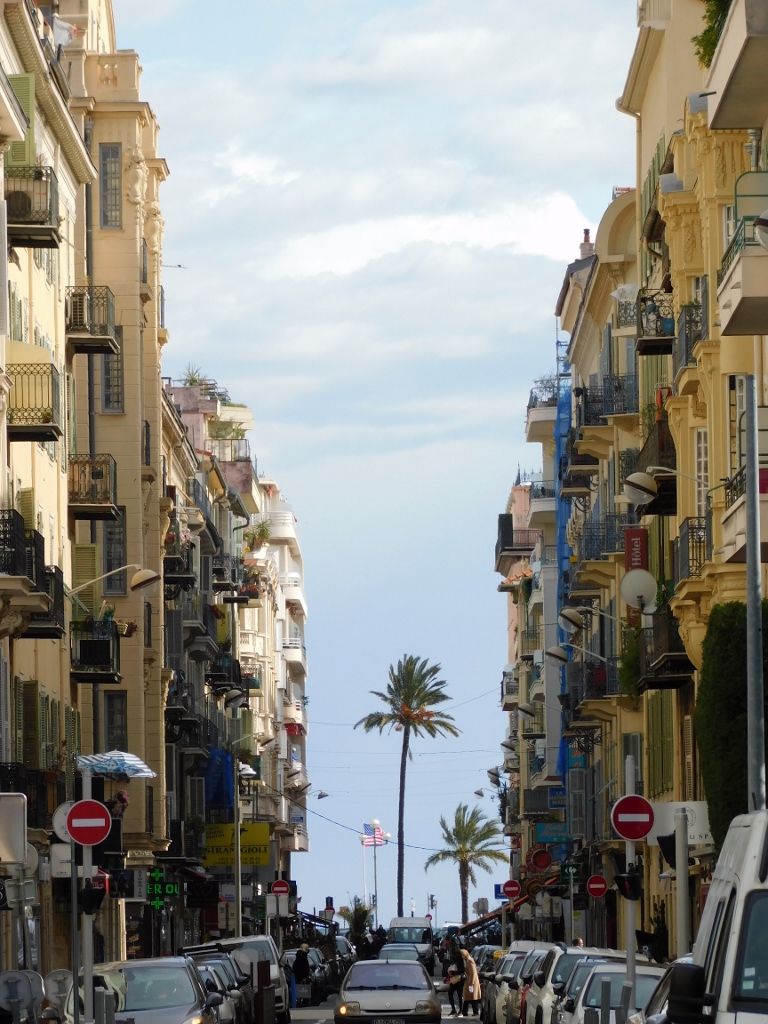 Street leading to the promenade by the sea
Street leading to the promenade by the sea
 Mediterranean Sea in Nice
Mediterranean Sea in Nice
The whole street running along the coast is called Promenade des Anglais and that means the Promenade of the English. Namely, it was precisely the wealthy Englishmen who in the 19th century contributed to the development of Nice as the destination for “winter summer vacations.”
Namely, already in the first half of the 19th century, the English aristocracy “discovered” this part of the Mediterranean Sea (at the time, Nice belonged to the Kingdom of Piedmont-Sardinia) where the winters were mild, especially in comparison to Great Britain, and so wealthy Englishmen started to come here in increased numbers building villas for themselves. Already in 1820 an idea started to take hold among the English to have a walkway built by the sea. The city of Nice took advantage of this idea eventually building a much longer walkway than the originally planned. By the way, today, the walkway is 7 km long!
When France annexed Nice in 1860, the walkway got the name that is used for it even nowadays. So, this is the Promenade des Anglais. Today, the walkway is good for all and not only for (wealthy) Englishmen.
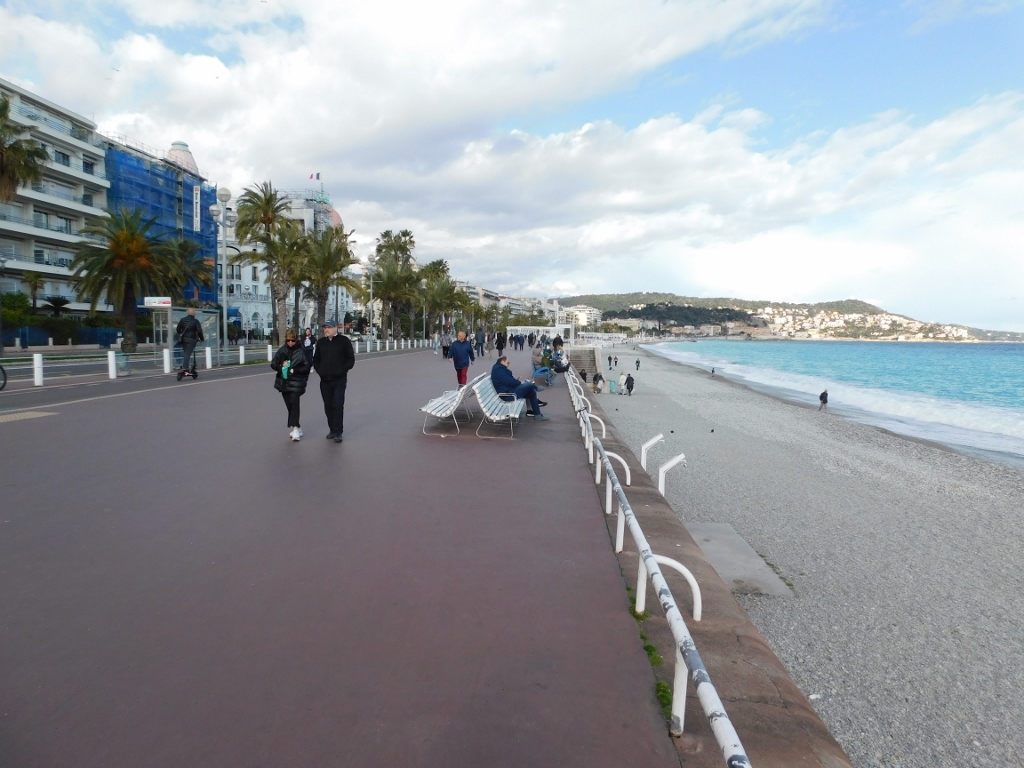 Promenade des Anglais
Promenade des Anglais
I went to Nice at the beginning of April and although it was officially already spring and although this is the Mediterranean coast and although it was rather sunny, it was also quite chilly. This could also be seen by the cafes that can be seen in several spots along the beach that is paralleled by the Promenade des Anglais.
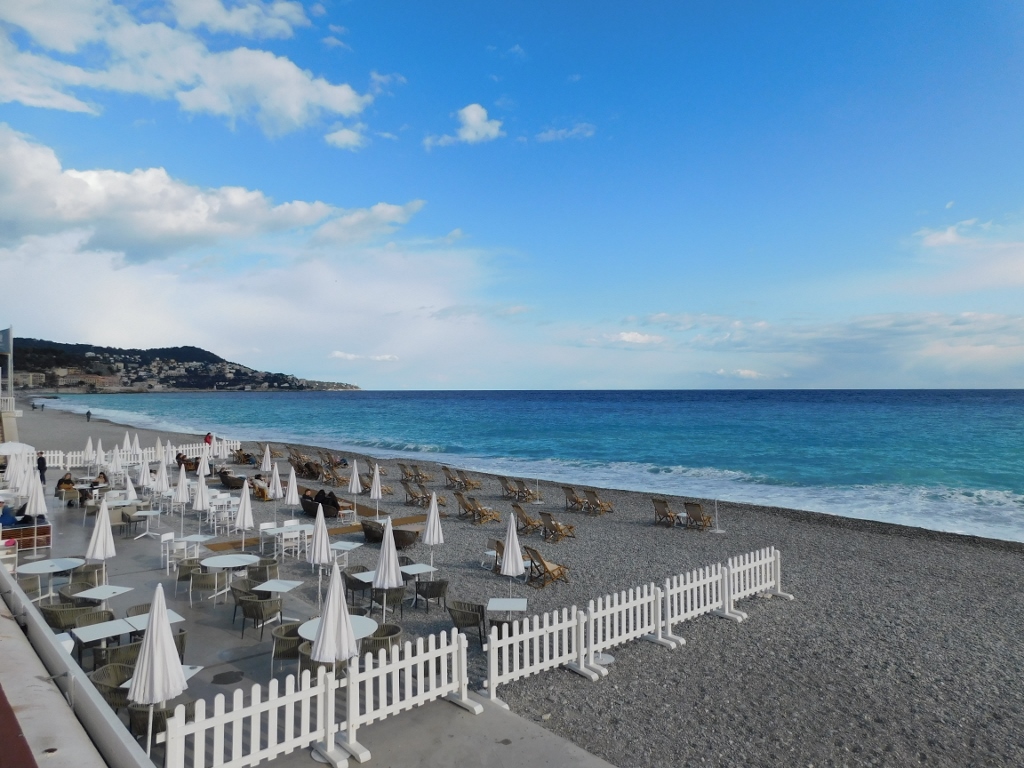 Some cafes are empty...
Some cafes are empty...
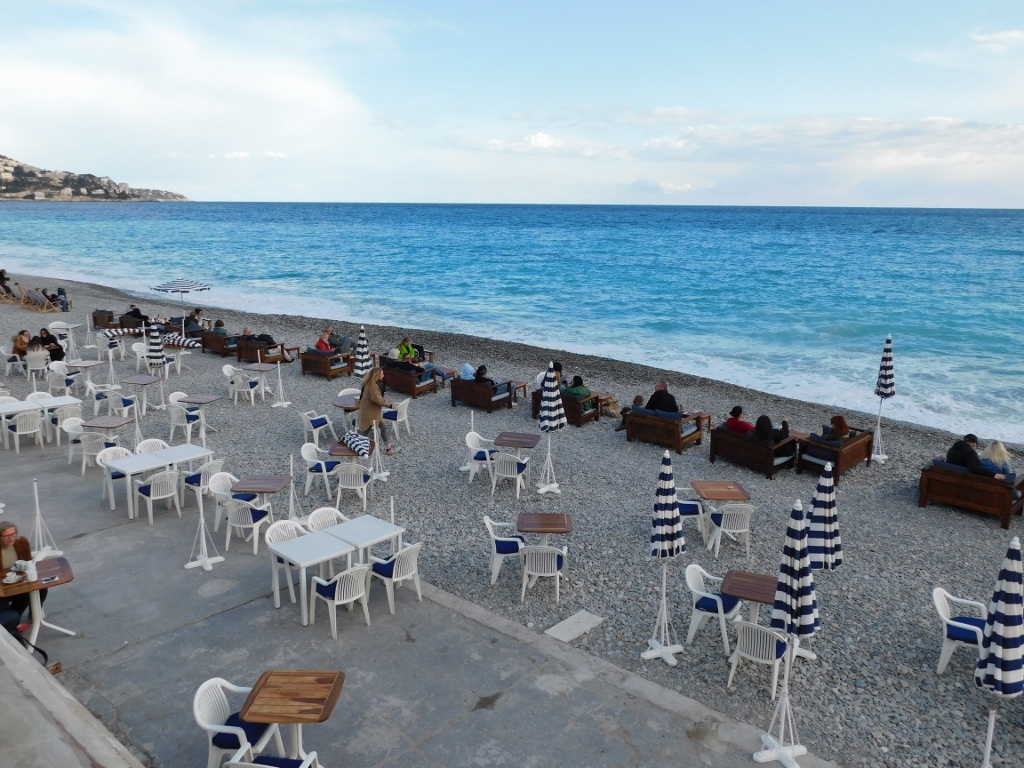 ... and in some there are brave guests
... and in some there are brave guests
Nice belongs to the Provence-Alpes-Côte d’Azur region. Since primarily members of the British aristocracy and higher classes started to come here regularly on account of those mild winters and the position of the city (on the sea coast, while being protected against the cold European winters by the high mountains), the urban development mostly suited the taste of foreigners. Not only did the city expanded outside its medieval core, but also the new buildings almost competed which one is going to be more grand. Here are a couple of specimens that can be seen beside the promenade.
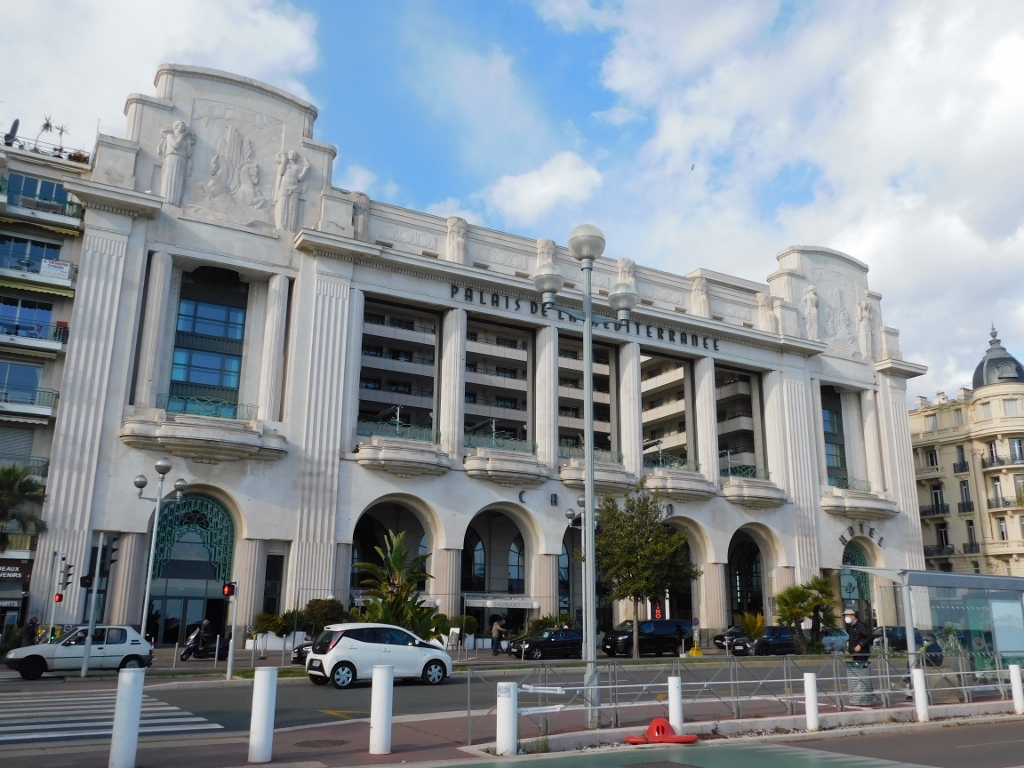 Famous hotel with its Art Deco facade
Famous hotel with its Art Deco facade
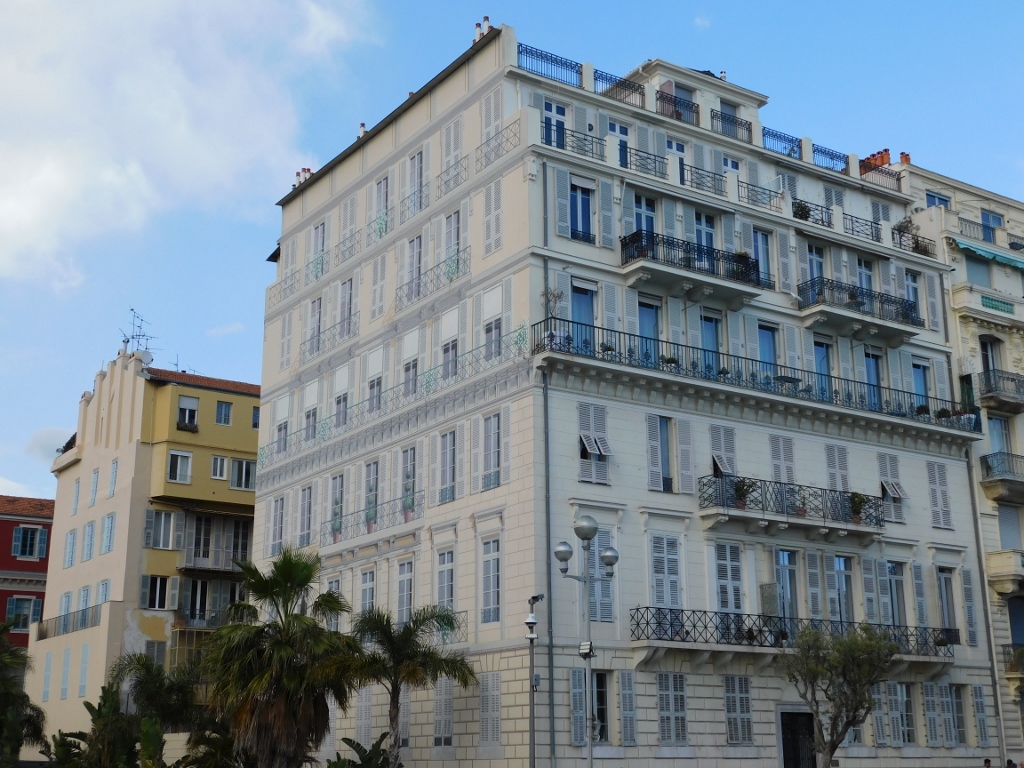 The windows and balconies on the front façade are real, while those on the flank are false (painted)
The windows and balconies on the front façade are real, while those on the flank are false (painted)
And so I reached the Opéra de Nice from 1885.
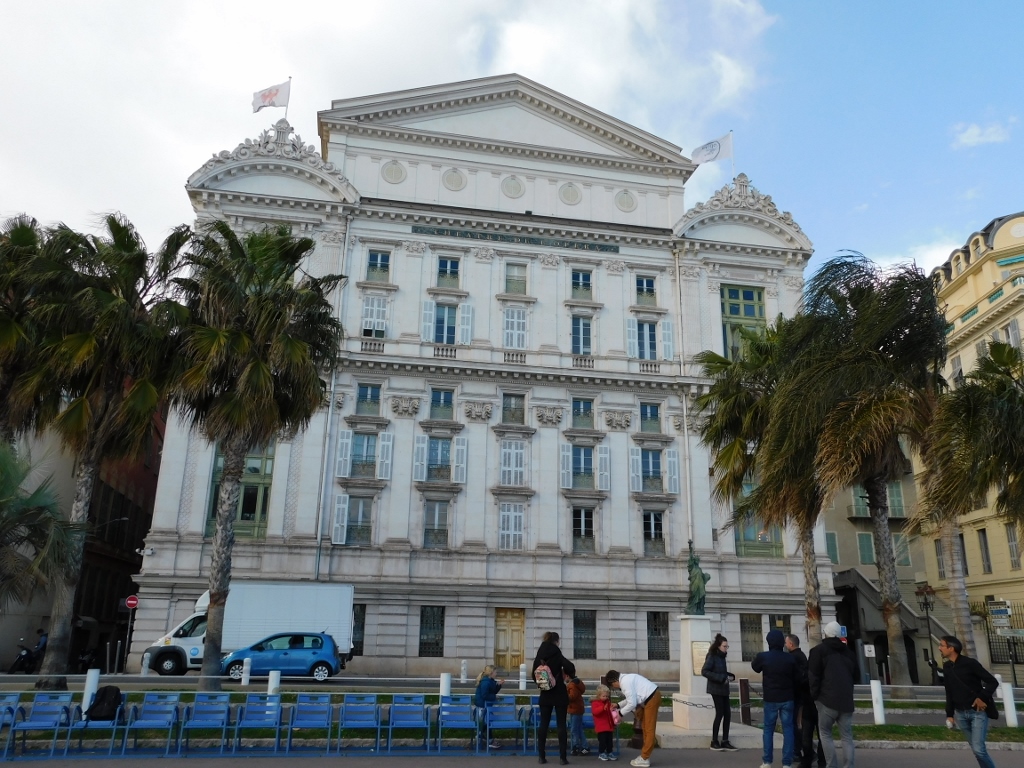 Opéra de Nice building
Opéra de Nice building
If you look a little more closely at the photo above, you can see a sculpture on a pedestal bottom right.
This is a significantly smaller version of the original “Liberty Enlightening the World” much better known under the name of the Statue of Liberty. Namely, this part of the promenade is called Quai des États-Unis (The United States Quay) and so in 2014 when the quay was renovated, the city of Nice placed this sculpture here as a reminder of the America-French friendship.
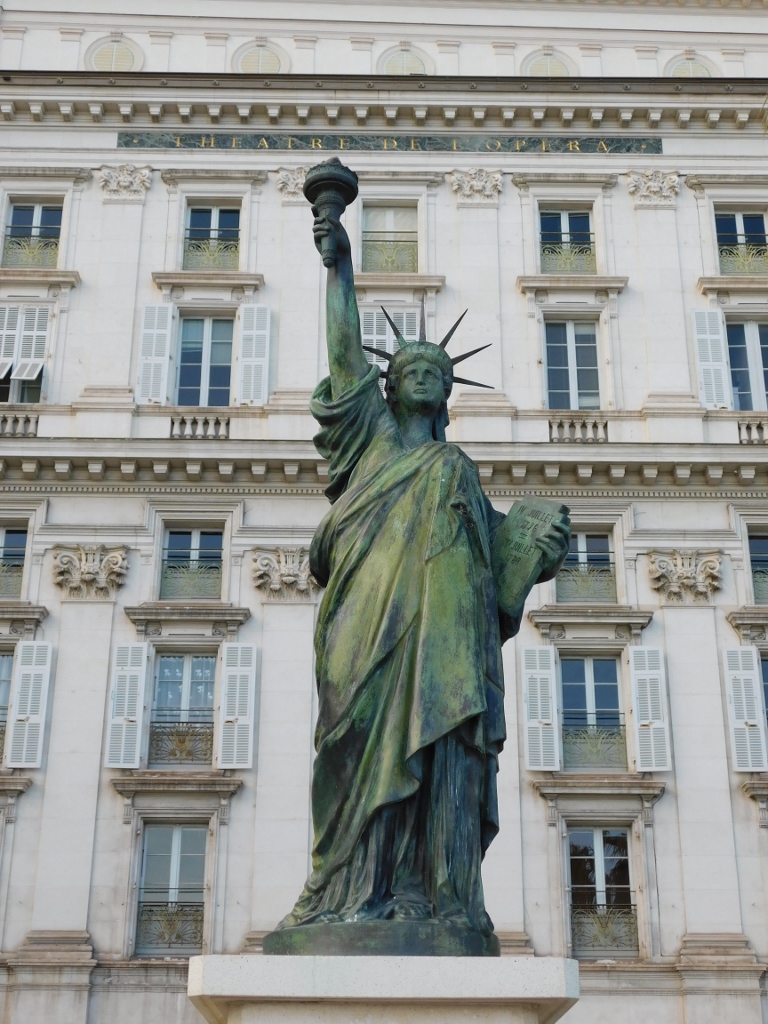 A smallish Statue of Liberty in front of the Opéra de Nice building
A smallish Statue of Liberty in front of the Opéra de Nice building
The Quai des États-Unis practically separates Old Nice from the beach, but this afternoon I was not interested in entering the Old Town, continuing rather to walk along the coast.
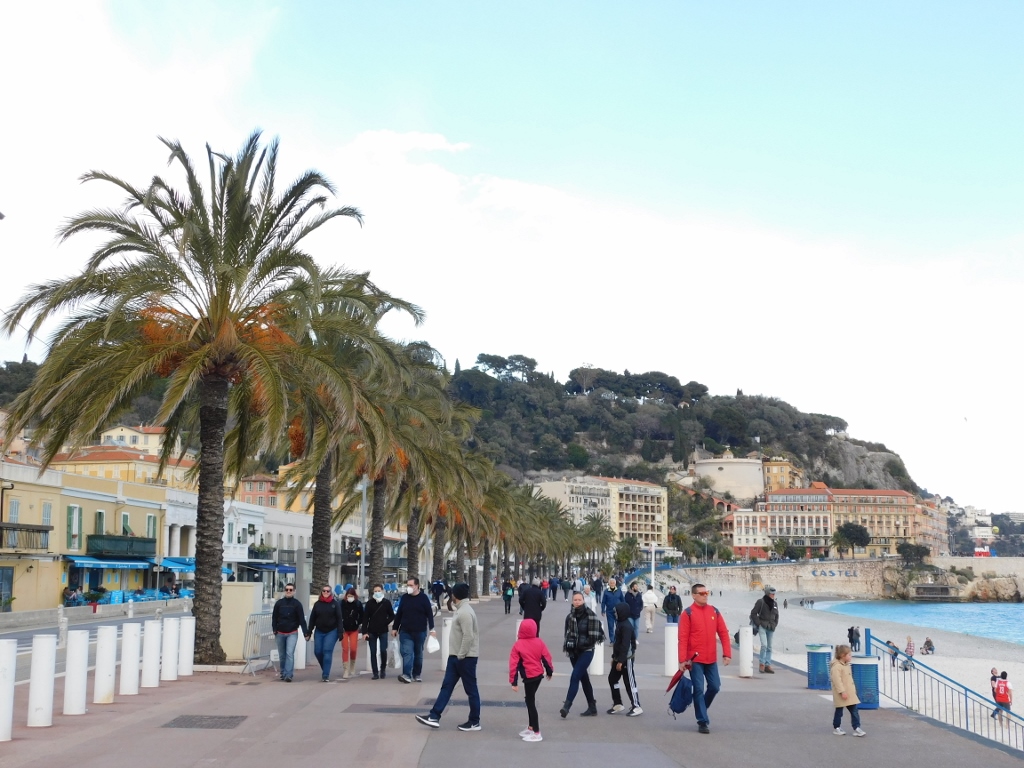 Walkway along the Quai des États-Unis
Walkway along the Quai des États-Unis
But, let me just say that the Old Town in Nice starts practically already on the other side of the street and almost right there is the famous Flower Market, Marché aux fleurs cours saleya, however, I left all of that for some other time. I was also not in the mood to climb the Castle Hill, Colline du Château, that can also be seen in the photo above. Although I must say that I have read that the climb is worth the while for in addition to a nice stroll in the park, one can also have a fine view at Nice.
I contended myself with walking around the hill and as the street goes up in that section I could still enjoy a fine view.
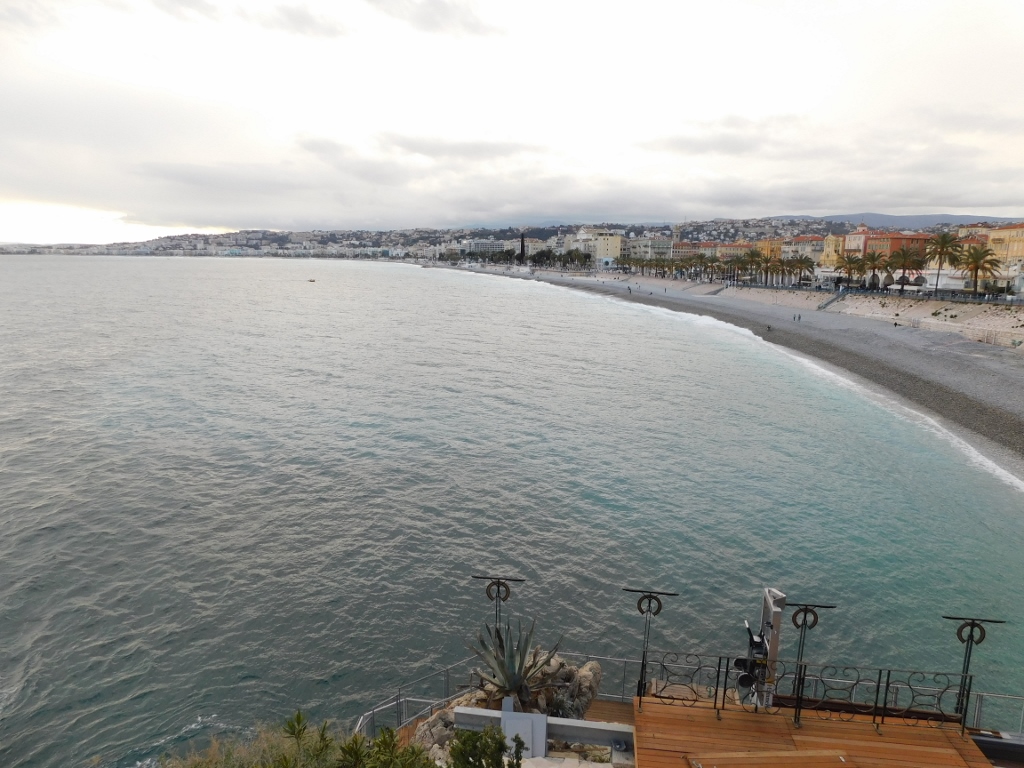 Nice
Nice
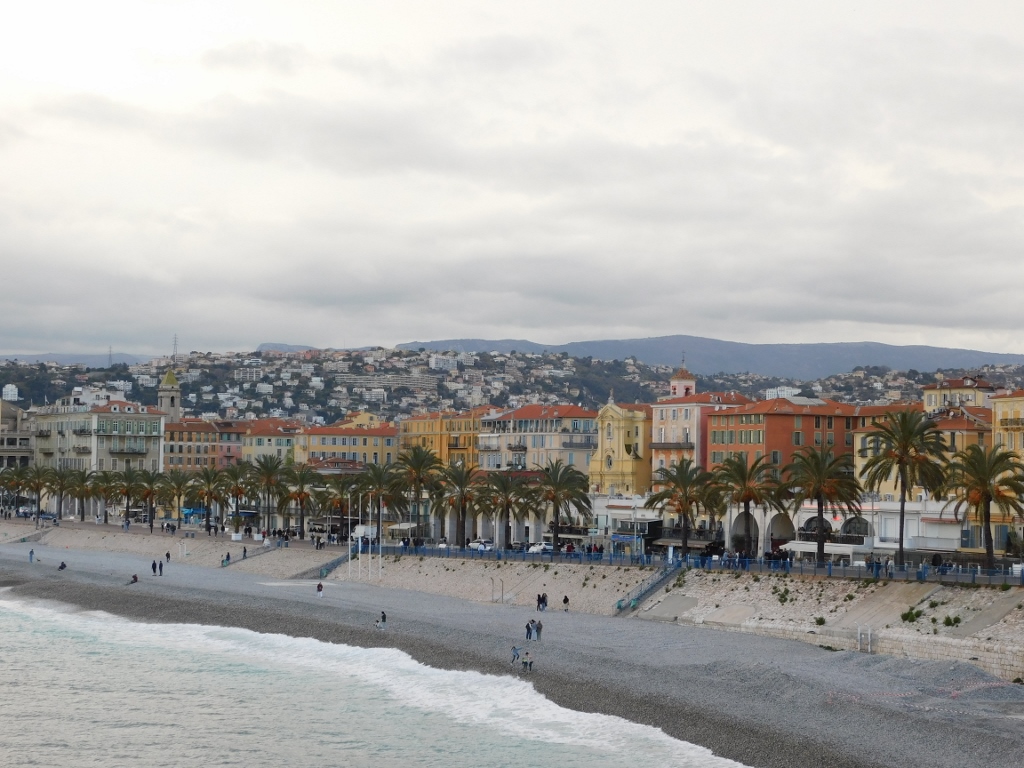 Quai des États-Unis where Old Nice starts
Quai des États-Unis where Old Nice starts
On the other side of the hill there is the Old Port of Nice.
 Old Port of Nice
Old Port of Nice
When I got to the end of the walkway seen in the previous photo, I noticed a house that had an information plaque on it. Namely, this house takes up the place where back in the day there used to be the birth-house of Giuseppe Garibaldi, the Italian revolutionary and fighter for Italian unity, who was born here on 4 July 1807.
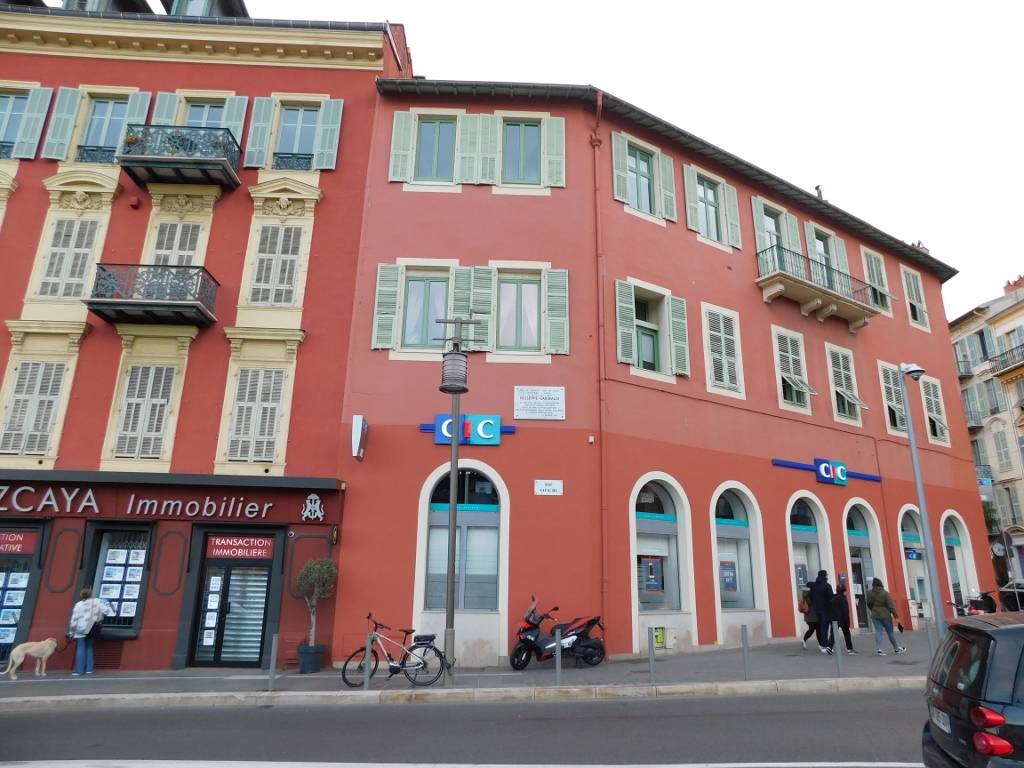 This is where the birth-house of Garibaldi used to be
This is where the birth-house of Garibaldi used to be
This reflects precisely the manifold mixture of French and Italian elements that intertwine here.
On the other side of the walkway, beside the port, I could see a tram that was currently parked here at its last or the first stop – depending on the point of view. Namely, the Old Port of Nice is also called Lympia Port, Port Lympia, and this is also the name of the train stop, while the tram I saw here belonged to the direct line that goes to/from the airport in Nice.
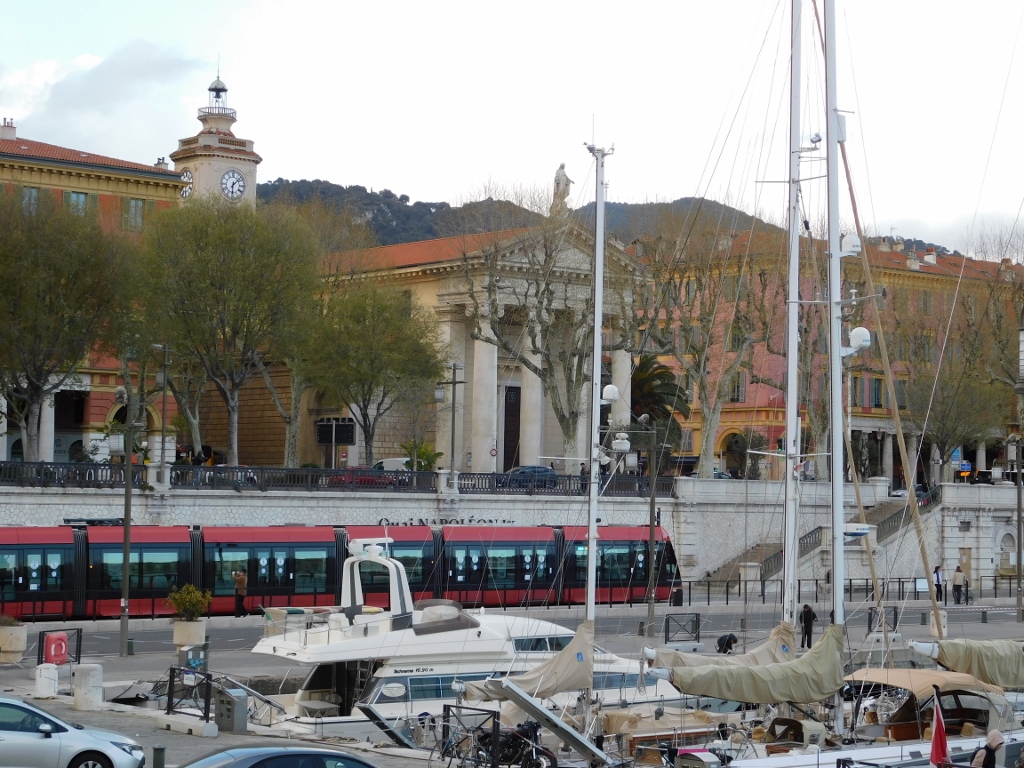 Tram at the Port Lympia stop
Tram at the Port Lympia stop
In the photo, one can also see the neo-classical Church of Our Lady of the Port of Nice, Église Notre-Dame-du-Port de Nice, the construction of which was completed in 1853.
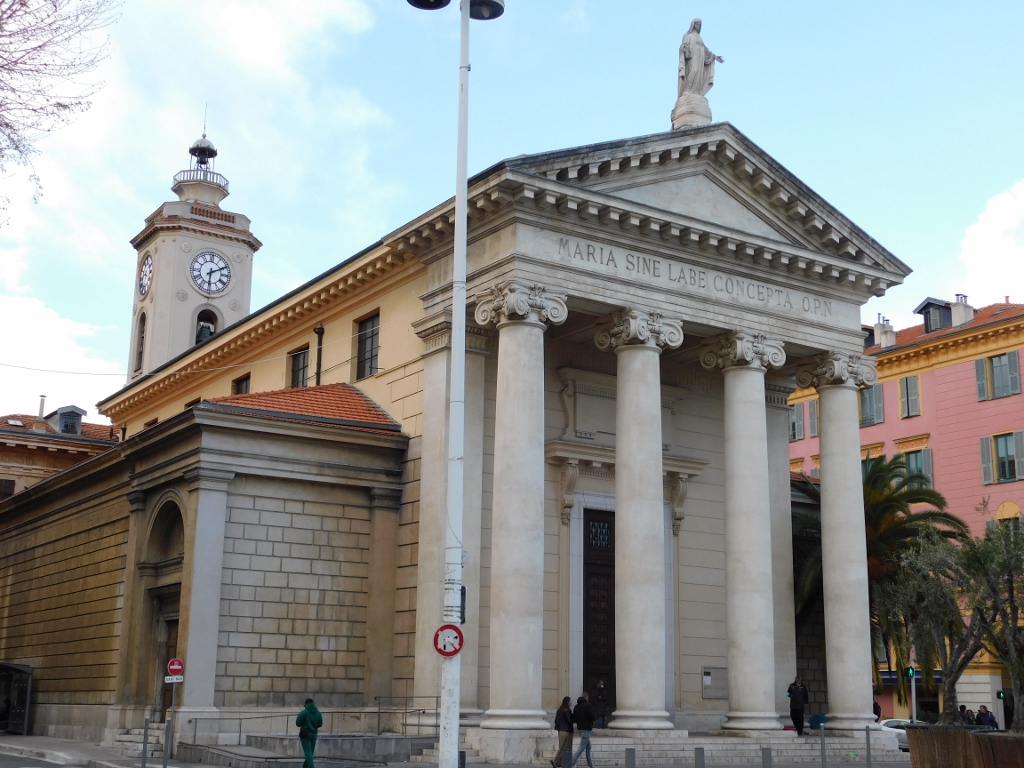 Church of Our Lady of the Port of Nice
Church of Our Lady of the Port of Nice
From there, there is also a fine view at the Old Port of Nice.
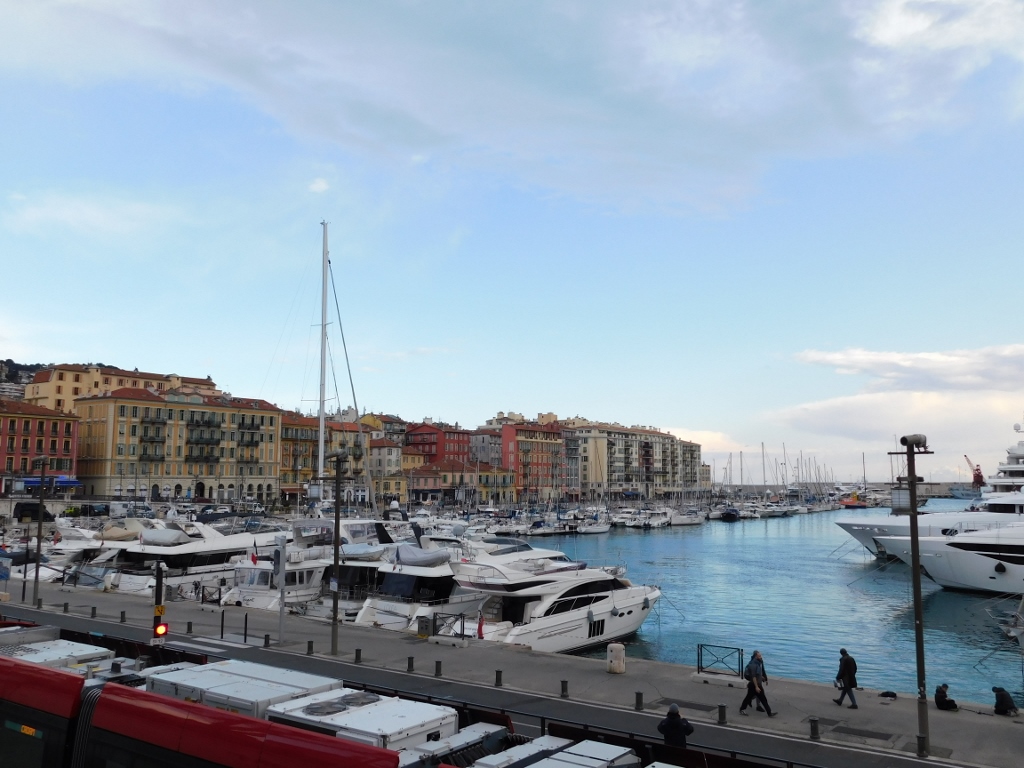 Old Port of Nice
Old Port of Nice
Then I ventured into the streets behind the Church of Our Lady and so I walked a little bit to the left and a little bit to the right, but generally not going too far away from the Castle Hill, since I knew that I had to return in that direction in order to get back eventually to the flat I rented during my stay in Nice.
 A street in Nice
A street in Nice
And so I reached Rue Bonaparte, a street full of cafes and restaurants. I realised it would be a good thing for me to eat something, but as I was not particularly hungry, I postponed this until later.
Here I also saw a shop window with wonderful traditional French sweets – the calisson. They are similar to marzipan, but with more pronounced fruit aroma and they are traditionally linked to the town of Aix-en-Provence, but, since Nice is also a part of Provence, then it makes sense for me to show these sweets that I took a photo of here.
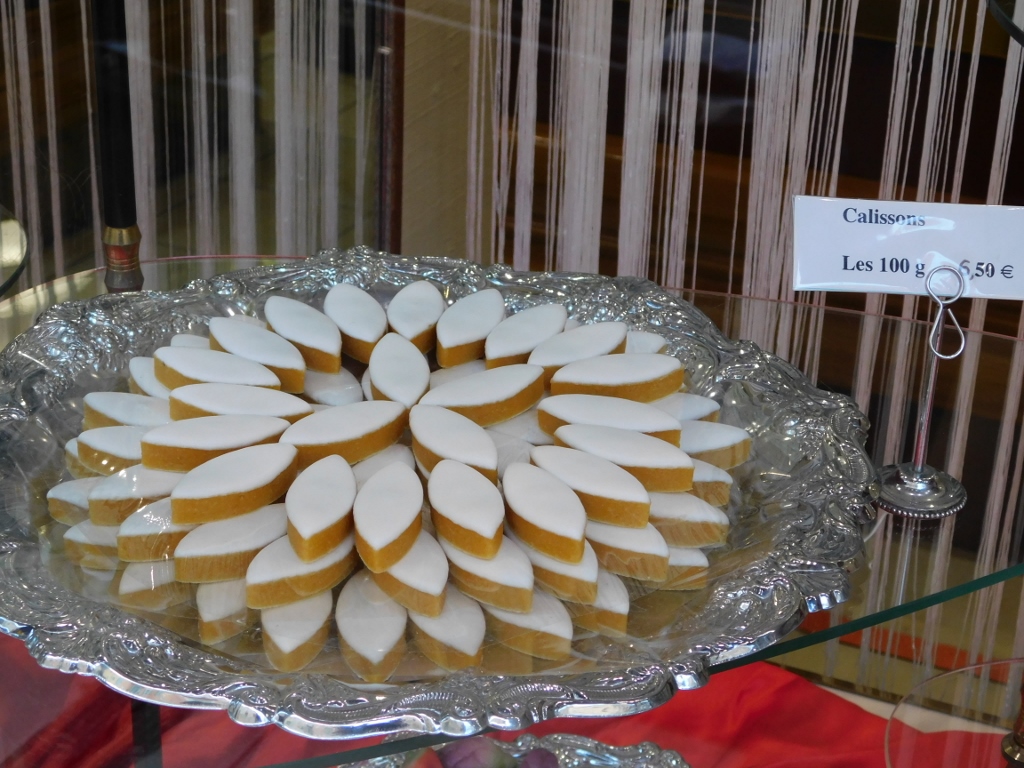 Calisson sweets
Calisson sweets
As I continued with my walk, soon I reached Garibaldi Square (Place Garibaldi).
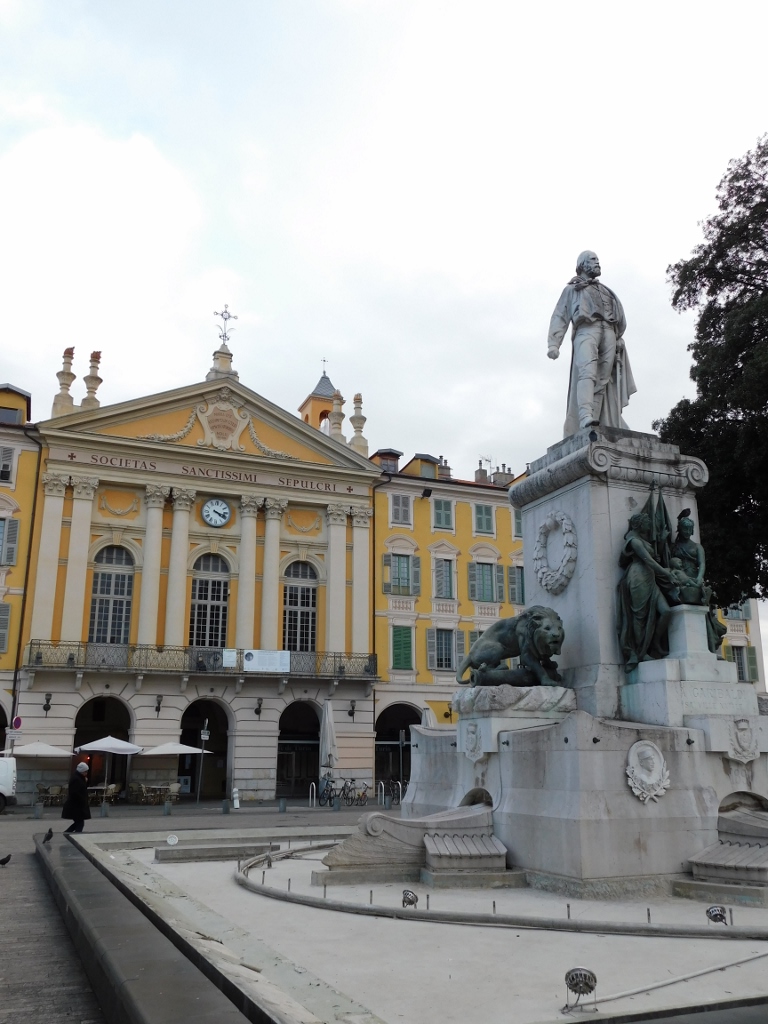 Garibaldi Monument and Square
Garibaldi Monument and Square
This spacious square was named after Garibaldi who was, as I’ve said, born in Nice and it is characterised by very elegant buildings it is surrounded with. One should in particular pay attention to the very interesting facades. If you look up more closely, you can clearly see that realistically the facades contain only windows and jalousie shutters. The rest is painted decoration. Of course, this does not concern the arches on the ground floor that are real.
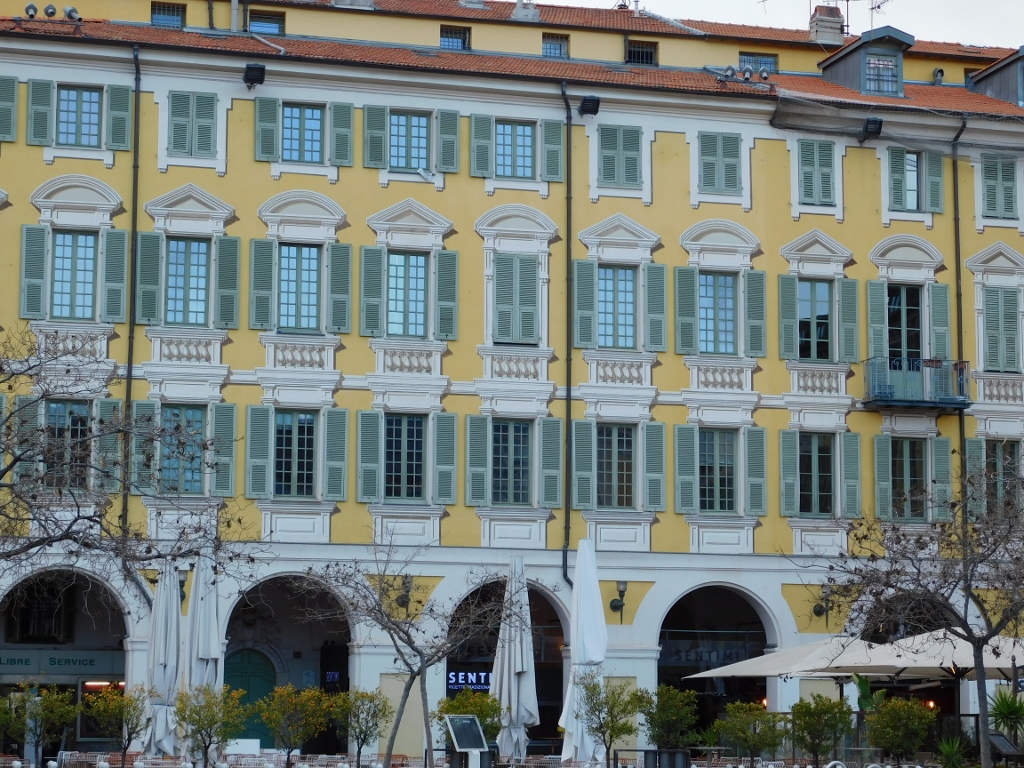 Garibaldi Square, a detail
Garibaldi Square, a detail
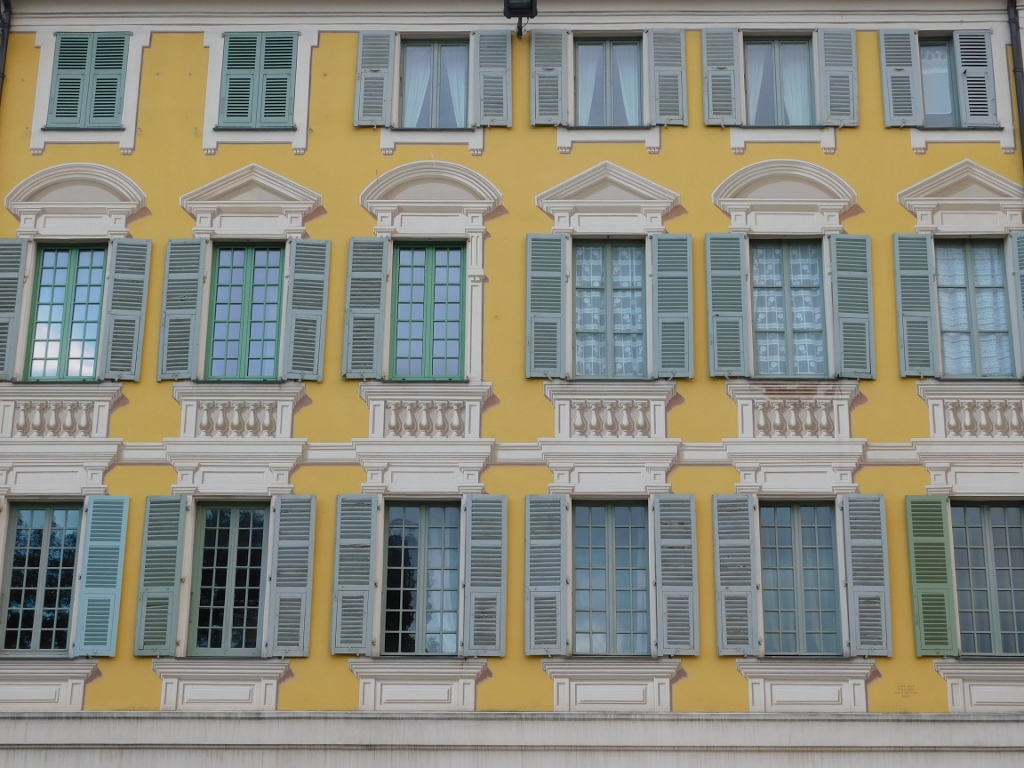 Garibaldi Square, a detail
Garibaldi Square, a detail
After the stroll around the square, I headed along the narrow streets of Old Nice. Formally speaking, Garibaldi Square also belongs to Old Nice, although it is situated on its perimeter..
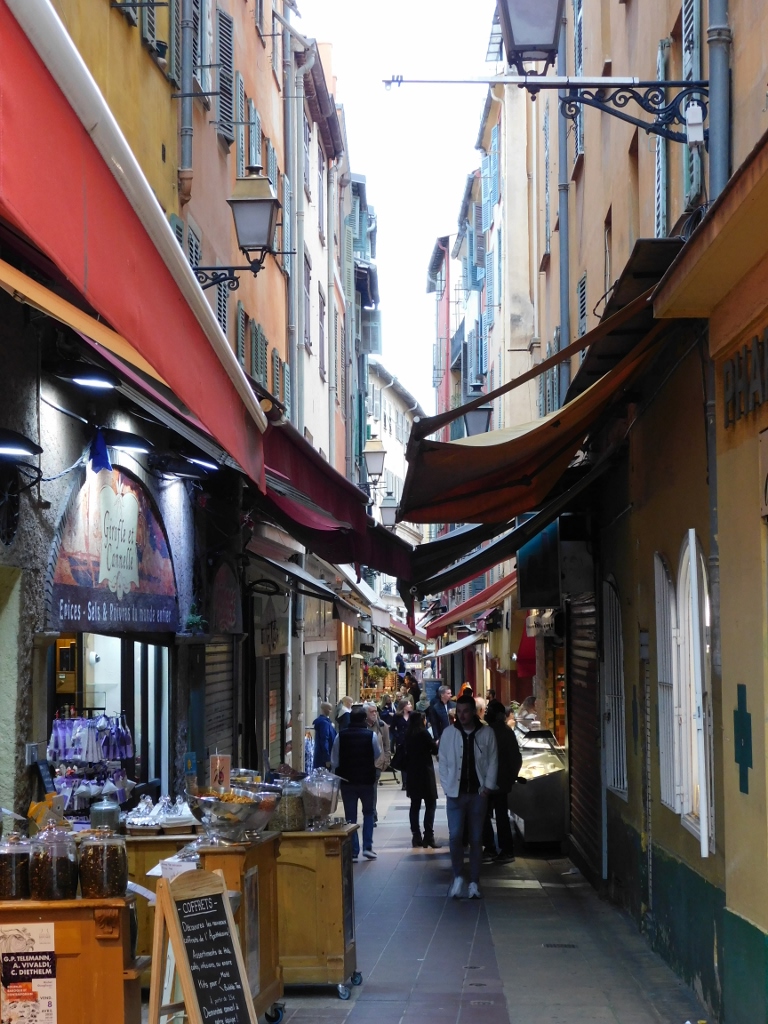 Old Nice, a detail
Old Nice, a detail
Some streets in Old Nice are full of shops for tourists, but there are also smaller cafes and restaurants. And so I came across one which, among other things, offered fish fritters that have nothing to do with the French Riviera, but they reminded me of Martinique (https://www.svudapodji.com/en/new-york-martinique-10/). This meant I had to make a short break here and then I decided to take a glass of panaché with the fish fritters, since I like to take this beverage when in France.
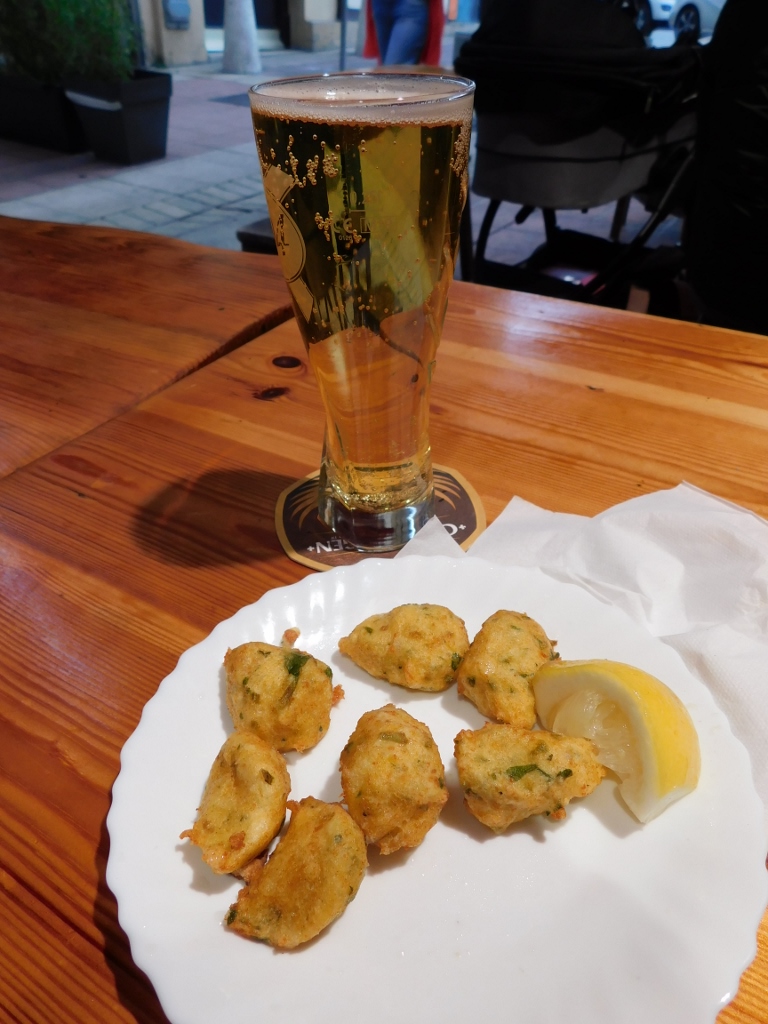 Sort of lunch
Sort of lunch
But, Old Nice is not for tourists alone. It is simply a very beautiful old part of a modern city.
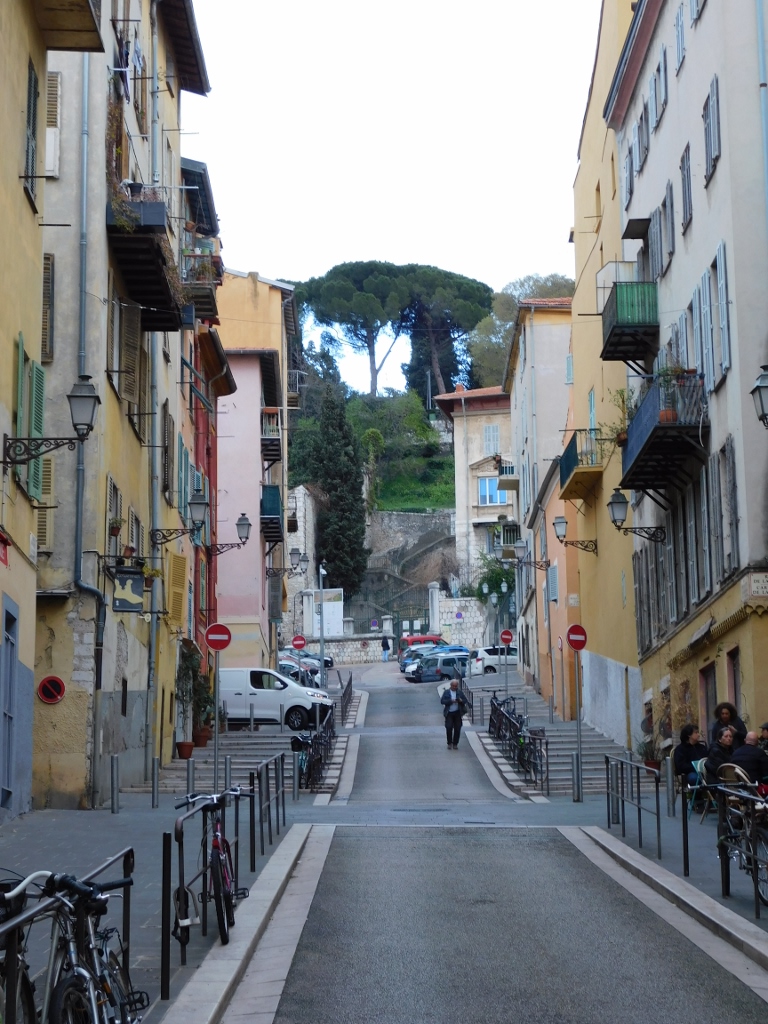 Old Nice, a detail
Old Nice, a detail
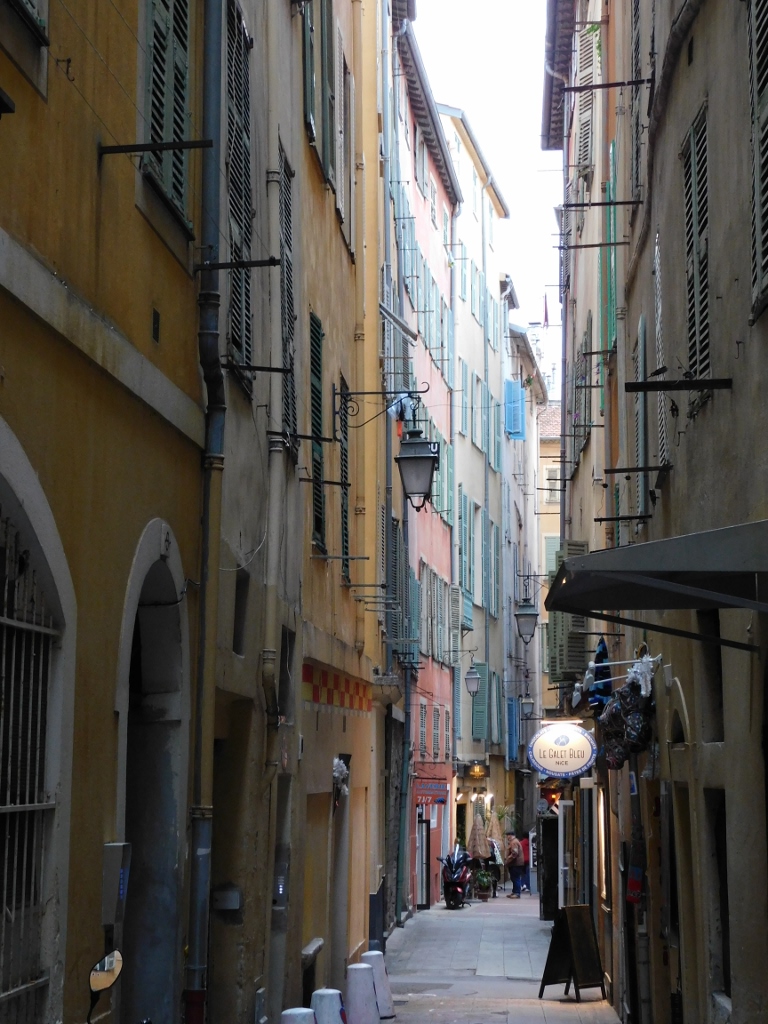 Old Nice, a detail
Old Nice, a detail
Wandering around the streets like that, I got to a square with the Justice Palace (Palais de Justice). In addition to the palace, there is also the Olive Tree sculpture that symbolises the entire South and that on this spot replaced some fountain.
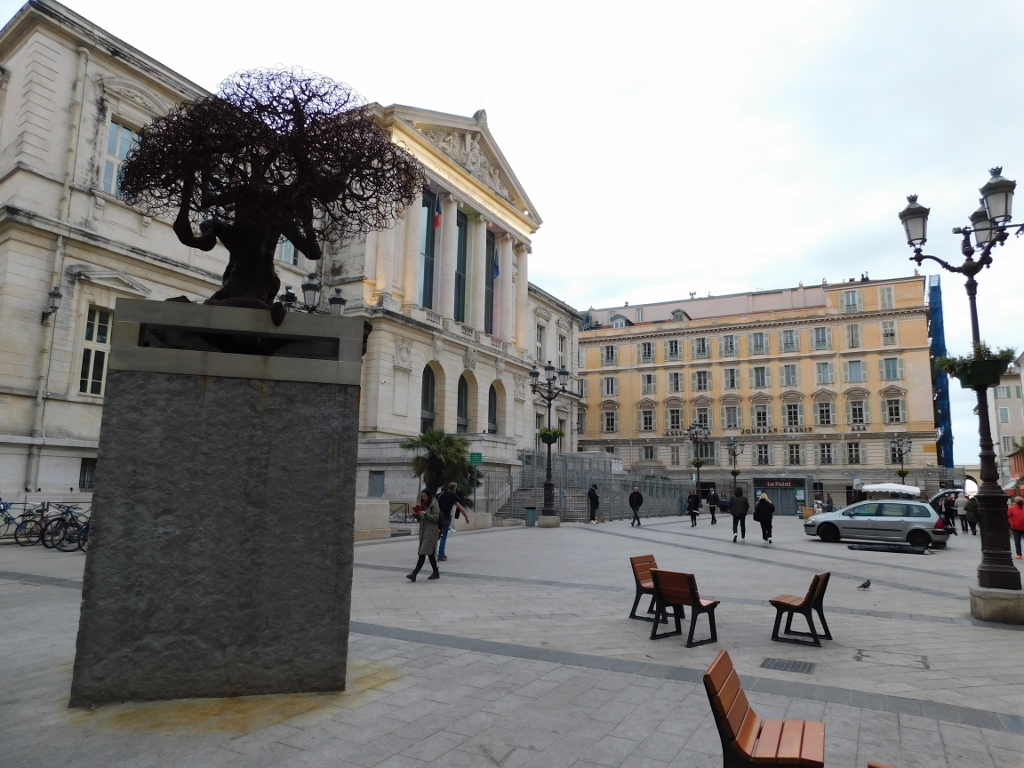 Old Nice, the square with the Justice Palace and the Olive Tree
Old Nice, the square with the Justice Palace and the Olive Tree
I found it interesting that this steel tree on a concrete base sculpture had been placed here less than a year before my visit to Nice. On the other side of the sculpture, there is one of the better known landmarks, the Palais Rusca, built in the eighth decade of the 18th century and used as a military barracks until 1990. Right next to the palace there is a Clock Tower. The first clock tower on this spot was built back in the 15th century, but then it was destroyed and restored several times. The last one was built in 1723 and it is interesting that until the construction of the Rusca Palace it just stood there isolated in the square. So, it was joined to the palace from the end of the 18th century.
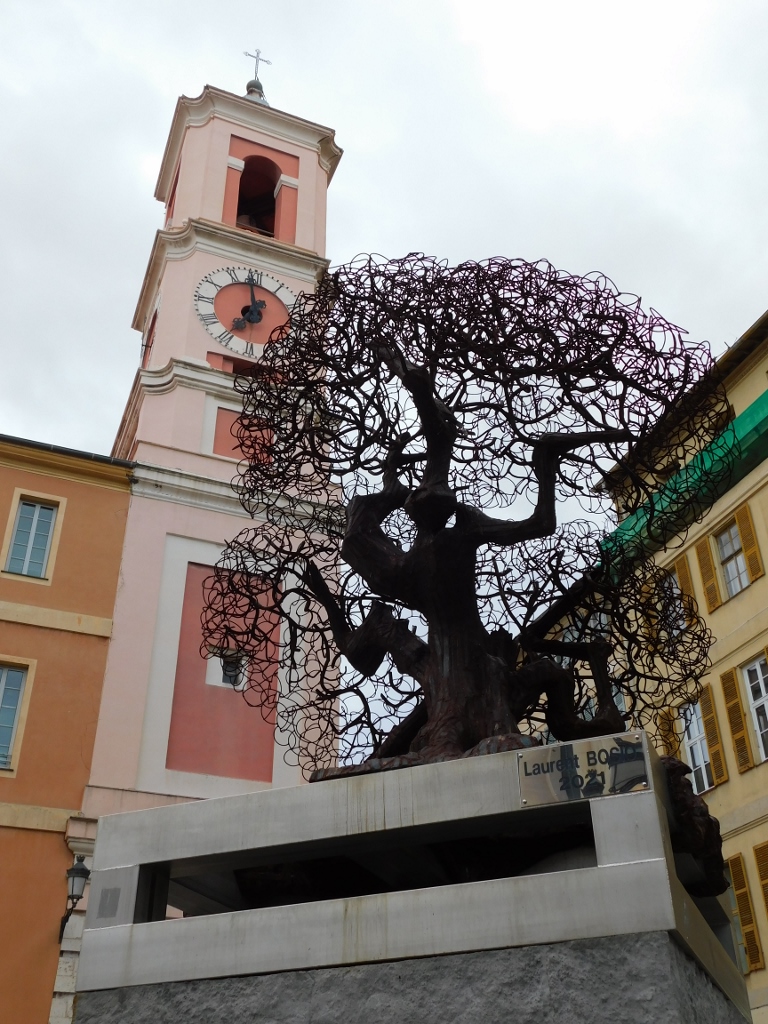 Old Nice, the steel Olive Tree and the Clock Tower
Old Nice, the steel Olive Tree and the Clock Tower
Soon I left Old Nice and moved to the newer part of the city, passing by a wide green corridor, Promenade du Paillon, that is like an elongated park along which there is a street as well as tram rails also installed on a grassy area.
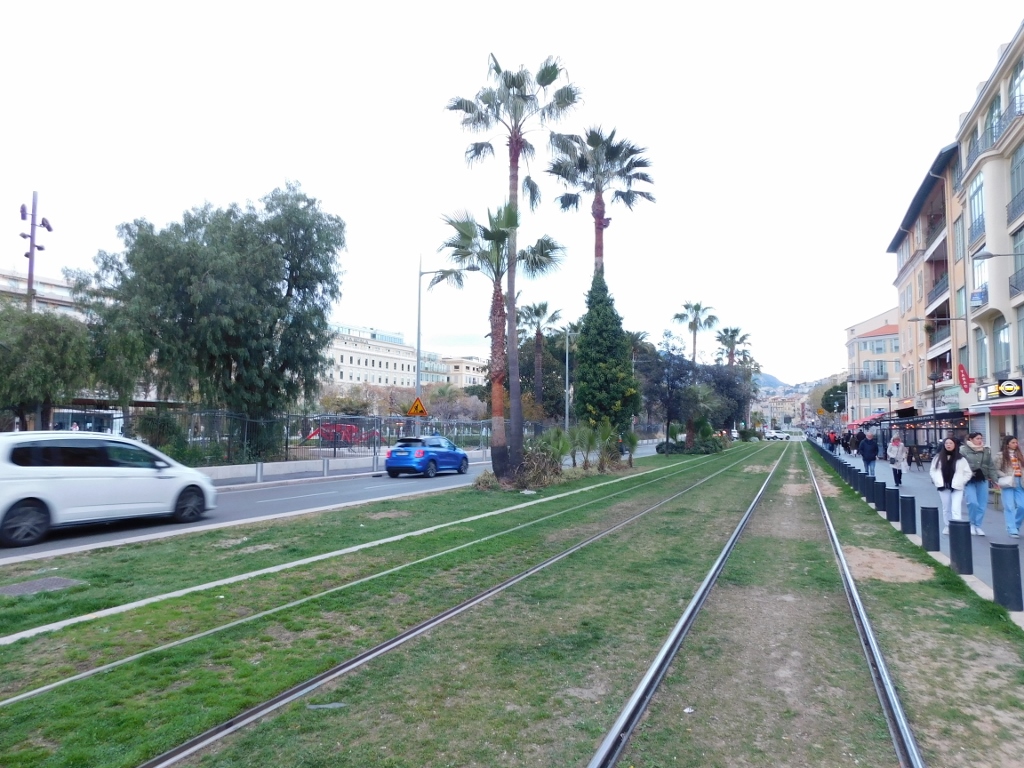 Nice, a detail
Nice, a detail
There is also a large square here, Masséna Square (Place Masséna), in the south end of which there is an impressive fountain and that semi-circular plateau is separated from the rest of the square by a wide avenue.
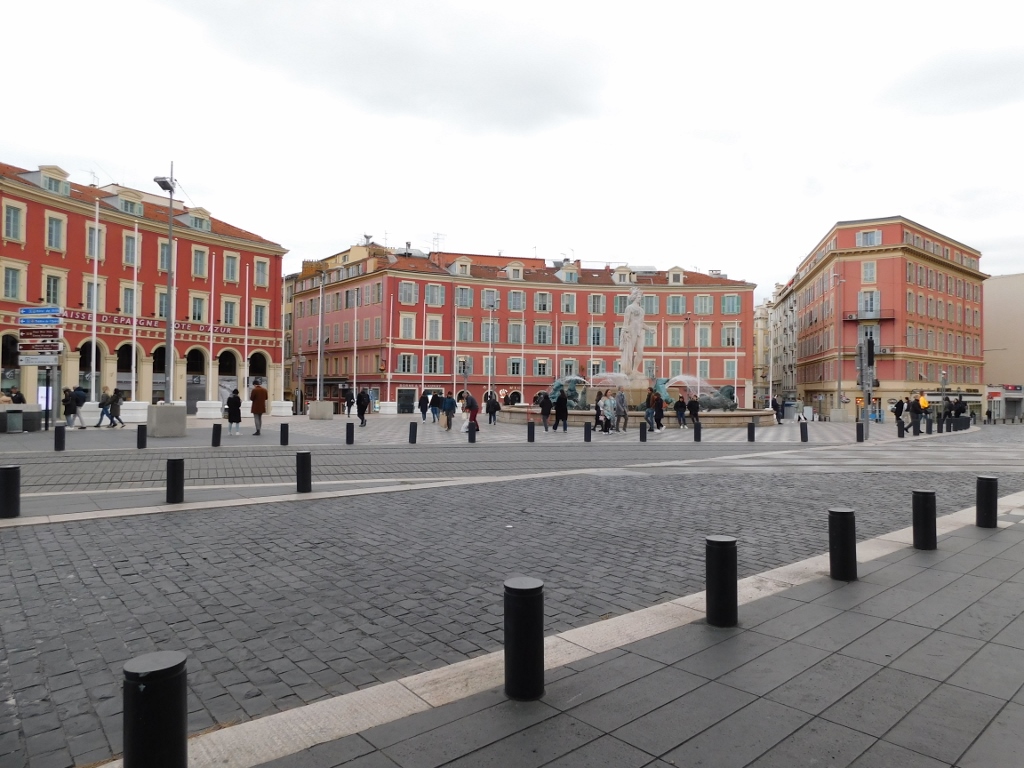 Semi-circular plateau with fountain
Semi-circular plateau with fountain
As for the fountain, this is the Sun Fountain (Fontaine du Soleil) in the middle of which there is an imposing marble statue of the Greek sun god, Apollo, 7 m high. The statue was placed here in 1956, but it was a subject of numerous controversies. So much so that it was even removed during the 1970s. But, in 2011, the statue was put back into its place and it seems that people bother with it less now than what they used to do in the second half of the 20th century.
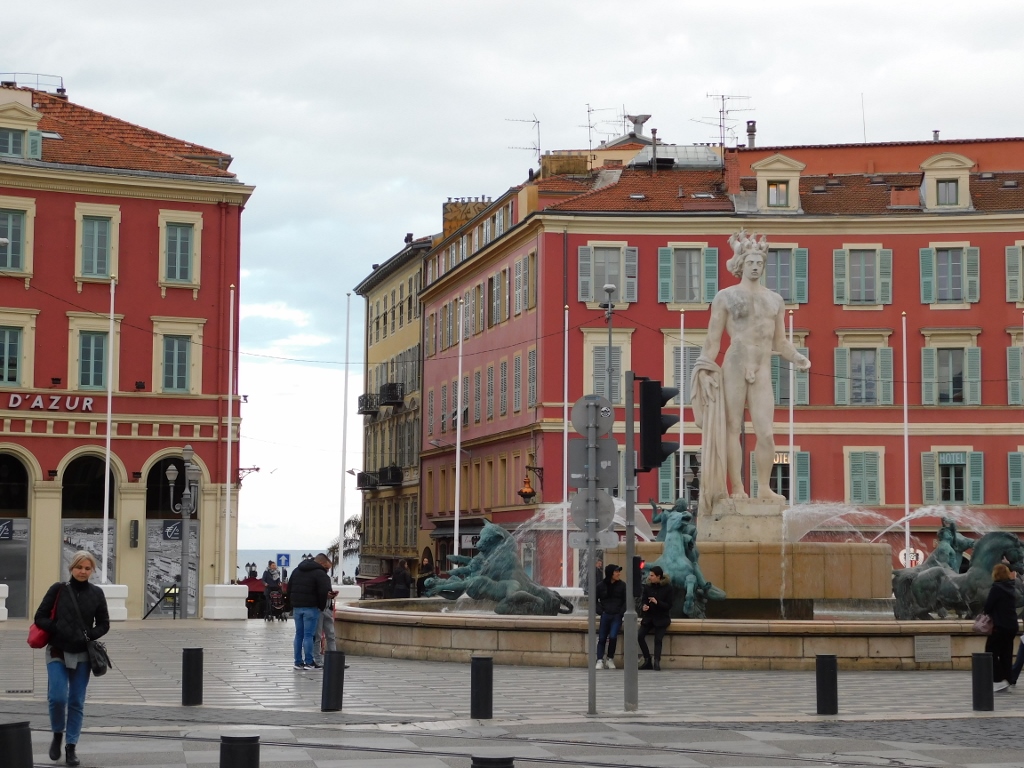 Sun Fountain; you can see the Mediterranean Sea in the background
Sun Fountain; you can see the Mediterranean Sea in the background
Walking across the Masséna Square, I headed further to the north, walking along a large street through the commercial part of the city.
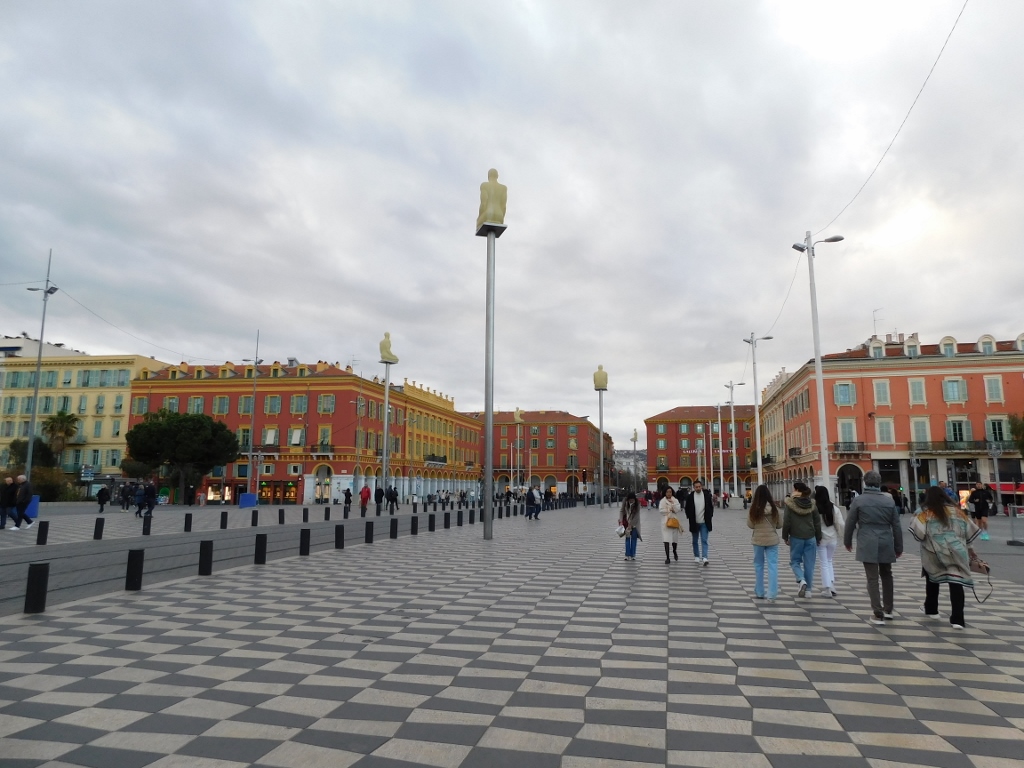 Masséna Square
Masséna Square
By this time I was tired and ready to go back to the flat that I rented, but along the way I did something that I do almost regularly when in France – I went to a supermarket where I bought a couple of different French cheeses, a fresh baguette and a bottle of wine. I did not need a better dinner.